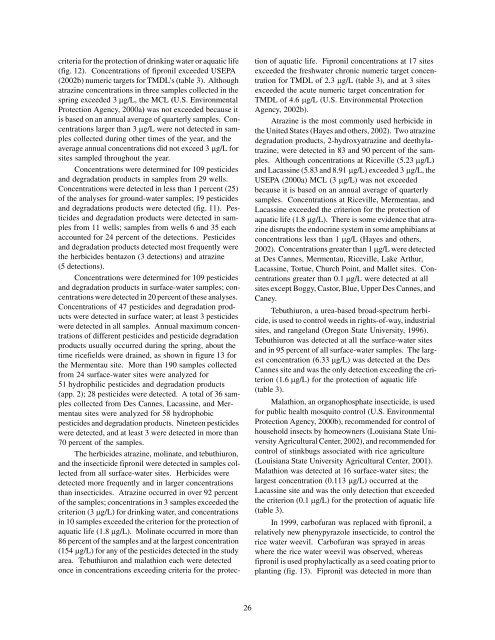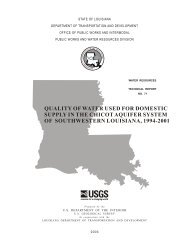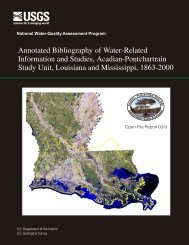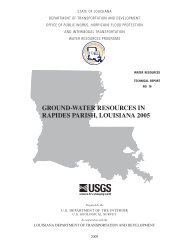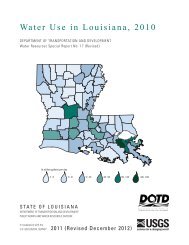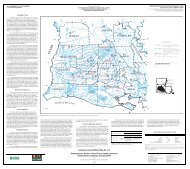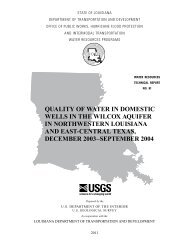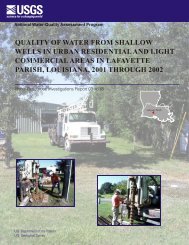environmental setting, water quality, and ecological indicators of
environmental setting, water quality, and ecological indicators of
environmental setting, water quality, and ecological indicators of
Create successful ePaper yourself
Turn your PDF publications into a flip-book with our unique Google optimized e-Paper software.
criteria for the protection <strong>of</strong> drinking <strong>water</strong> or aquatic life<br />
(fig. 12). Concentrations <strong>of</strong> fipronil exceeded USEPA<br />
(2002b) numeric targets for TMDL’s (table 3). Although<br />
atrazine concentrations in three samples collected in the<br />
spring exceeded 3 µg/L, the MCL (U.S. Environmental<br />
Protection Agency, 2000a) was not exceeded because it<br />
is based on an annual average <strong>of</strong> quarterly samples. Concentrations<br />
larger than 3 µg/L were not detected in samples<br />
collected during other times <strong>of</strong> the year, <strong>and</strong> the<br />
average annual concentrations did not exceed 3 µg/L for<br />
sites sampled throughout the year.<br />
Concentrations were determined for 109 pesticides<br />
<strong>and</strong> degradation products in samples from 29 wells.<br />
Concentrations were detected in less than 1 percent (25)<br />
<strong>of</strong> the analyses for ground-<strong>water</strong> samples; 19 pesticides<br />
<strong>and</strong> degradations products were detected (fig. 11). Pesticides<br />
<strong>and</strong> degradation products were detected in samples<br />
from 11 wells; samples from wells 6 <strong>and</strong> 35 each<br />
accounted for 24 percent <strong>of</strong> the detections. Pesticides<br />
<strong>and</strong> degradation products detected most frequently were<br />
the herbicides bentazon (3 detections) <strong>and</strong> atrazine<br />
(5 detections).<br />
Concentrations were determined for 109 pesticides<br />
<strong>and</strong> degradation products in surface-<strong>water</strong> samples; concentrations<br />
were detected in 20 percent <strong>of</strong> these analyses.<br />
Concentrations <strong>of</strong> 47 pesticides <strong>and</strong> degradation products<br />
were detected in surface <strong>water</strong>; at least 3 pesticides<br />
were detected in all samples. Annual maximum concentrations<br />
<strong>of</strong> different pesticides <strong>and</strong> pesticide degradation<br />
products usually occurred during the spring, about the<br />
time ricefields were drained, as shown in figure 13 for<br />
the Mermentau site. More than 190 samples collected<br />
from 24 surface-<strong>water</strong> sites were analyzed for<br />
51 hydrophilic pesticides <strong>and</strong> degradation products<br />
(app. 2); 28 pesticides were detected. A total <strong>of</strong> 36 samples<br />
collected from Des Cannes, Lacassine, <strong>and</strong> Mermentau<br />
sites were analyzed for 58 hydrophobic<br />
pesticides <strong>and</strong> degradation products. Nineteen pesticides<br />
were detected, <strong>and</strong> at least 3 were detected in more than<br />
70 percent <strong>of</strong> the samples.<br />
The herbicides atrazine, molinate, <strong>and</strong> tebuthiuron,<br />
<strong>and</strong> the insecticide fipronil were detected in samples collected<br />
from all surface-<strong>water</strong> sites. Herbicides were<br />
detected more frequently <strong>and</strong> in larger concentrations<br />
than insecticides. Atrazine occurred in over 92 percent<br />
<strong>of</strong> the samples; concentrations in 3 samples exceeded the<br />
criterion (3 µg/L) for drinking <strong>water</strong>, <strong>and</strong> concentrations<br />
in 10 samples exceeded the criterion for the protection <strong>of</strong><br />
aquatic life (1.8 µg/L). Molinate occurred in more than<br />
86 percent <strong>of</strong> the samples <strong>and</strong> at the largest concentration<br />
(154 µg/L) for any <strong>of</strong> the pesticides detected in the study<br />
area. Tebuthiuron <strong>and</strong> malathion each were detected<br />
once in concentrations exceeding criteria for the protec-<br />
26<br />
tion <strong>of</strong> aquatic life. Fipronil concentrations at 17 sites<br />
exceeded the fresh<strong>water</strong> chronic numeric target concentration<br />
for TMDL <strong>of</strong> 2.3 µg/L (table 3), <strong>and</strong> at 3 sites<br />
exceeded the acute numeric target concentration for<br />
TMDL <strong>of</strong> 4.6 µg/L (U.S. Environmental Protection<br />
Agency, 2002b).<br />
Atrazine is the most commonly used herbicide in<br />
the United States (Hayes <strong>and</strong> others, 2002). Two atrazine<br />
degradation products, 2-hydroxyatrazine <strong>and</strong> deethylatrazine,<br />
were detected in 83 <strong>and</strong> 90 percent <strong>of</strong> the samples.<br />
Although concentrations at Riceville (5.23 µg/L)<br />
<strong>and</strong> Lacassine (5.83 <strong>and</strong> 8.91 µg/L) exceeded 3 µg/L, the<br />
USEPA (2000a) MCL (3 µg/L) was not exceeded<br />
because it is based on an annual average <strong>of</strong> quarterly<br />
samples. Concentrations at Riceville, Mermentau, <strong>and</strong><br />
Lacassine exceeded the criterion for the protection <strong>of</strong><br />
aquatic life (1.8 µg/L). There is some evidence that atrazine<br />
disrupts the endocrine system in some amphibians at<br />
concentrations less than 1 µg/L (Hayes <strong>and</strong> others,<br />
2002). Concentrations greater than 1 µg/L were detected<br />
at Des Cannes, Mermentau, Riceville, Lake Arthur,<br />
Lacassine, Tortue, Church Point, <strong>and</strong> Mallet sites. Concentrations<br />
greater than 0.1 µg/L were detected at all<br />
sites except Boggy, Castor, Blue, Upper Des Cannes, <strong>and</strong><br />
Caney.<br />
Tebuthiuron, a urea-based broad-spectrum herbicide,<br />
is used to control weeds in rights-<strong>of</strong>-way, industrial<br />
sites, <strong>and</strong> rangel<strong>and</strong> (Oregon State University, 1996).<br />
Tebuthiuron was detected at all the surface-<strong>water</strong> sites<br />
<strong>and</strong> in 95 percent <strong>of</strong> all surface-<strong>water</strong> samples. The largest<br />
concentration (6.33 µg/L) was detected at the Des<br />
Cannes site <strong>and</strong> was the only detection exceeding the criterion<br />
(1.6 µg/L) for the protection <strong>of</strong> aquatic life<br />
(table 3).<br />
Malathion, an organophosphate insecticide, is used<br />
for public health mosquito control (U.S. Environmental<br />
Protection Agency, 2000b), recommended for control <strong>of</strong><br />
household insects by homeowners (Louisiana State University<br />
Agricultural Center, 2002), <strong>and</strong> recommended for<br />
control <strong>of</strong> stinkbugs associated with rice agriculture<br />
(Louisiana State University Agricultural Center, 2001).<br />
Malathion was detected at 16 surface-<strong>water</strong> sites; the<br />
largest concentration (0.113 µg/L) occurred at the<br />
Lacassine site <strong>and</strong> was the only detection that exceeded<br />
the criterion (0.1 µg/L) for the protection <strong>of</strong> aquatic life<br />
(table 3).<br />
In 1999, carb<strong>of</strong>uran was replaced with fipronil, a<br />
relatively new phenypyrazole insecticide, to control the<br />
rice <strong>water</strong> weevil. Carb<strong>of</strong>uran was sprayed in areas<br />
where the rice <strong>water</strong> weevil was observed, whereas<br />
fipronil is used prophylactically as a seed coating prior to<br />
planting (fig. 13). Fipronil was detected in more than


